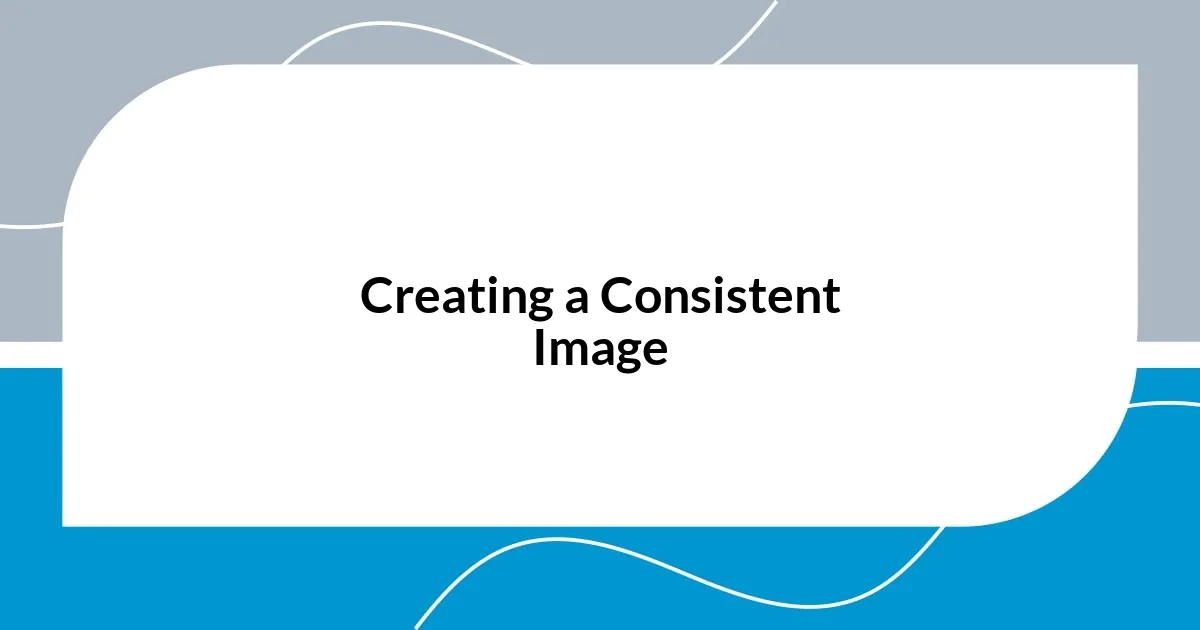Key takeaways:
- Author branding is about conveying your unique voice and vision to create a connection with readers, beyond just visuals or taglines.
- Identifying your unique voice is an ongoing process influenced by personal experiences and authenticity, enriching your writing and brand.
- A consistent image across platforms fosters recognition, using elements like visual consistency, tone, and personal storytelling.
- Engaging with your audience through direct communication and sharing behind-the-scenes content builds genuine connections and community.

Understanding Author Branding
When I first embarked on my writing journey, I struggled to understand what author branding truly meant. It felt daunting, almost like trying to define who I was in just a few words. But I soon realized that author branding isn’t just about a catchy tagline or a stylish book cover; it’s about conveying my unique voice and vision to my audience.
Think about it: what emotions do you want to evoke in your readers? For me, it’s about creating a sense of connection. I find that when I share my authentic experiences—like the time I wrote my first story while sitting on my grandmother’s porch—it resonates deeply with others. This connection lays the foundation for my brand, transforming casual readers into loyal fans who recognize and trust my work.
Branding also involves understanding how I want to position myself in the literary landscape. Do I want to be seen as an authority in a particular genre, or perhaps as a versatile storyteller? I often ask myself: what do I stand for? Your answers to these questions can greatly influence the audience you attract and the community you build around your writing.

Identifying Your Unique Voice
Identifying your unique voice is essential in shaping your author brand. I remember when I first discovered my voice during a writing workshop. I was hesitant to share my work, but once I did, the feedback revealed something profound: my stories had a raw honesty that resonated with others. That moment was pivotal; I realized my voice comes from authenticity, and it’s something I needed to embrace as I crafted my brand.
It’s also important to consider how your experiences shape your voice. For instance, I often draw inspiration from my travels, weaving personal stories into my narratives. This not only enriches my writing but also creates a distinct flavor that readers identify with. They can sense my passion and curiosity, and that connection fosters a sense of belonging in my author community.
In my journey, I’ve learned that identifying my unique voice is an ongoing process. Some days, I feel clear and confident; other days, doubt creeps in. By experimenting with different styles and genres, I continually refine my voice. Have you ever felt that push and pull in your own writing? I encourage you to embrace those moments of uncertainty—they often lead to the most profound discoveries.
| Aspect | Description |
|---|---|
| Authenticity | Your true self should shine through; honest stories create strong connections. |
| Experience | Personal experiences enrich your voice and set you apart from others. |
| Ongoing Exploration | Your voice evolves; embrace changes and experiment with styles to find what resonates. |

Creating a Consistent Image
Creating a consistent image is crucial in author branding, as it helps your audience recognize and relate to you. When I decided to use a specific color palette for my social media profiles, it wasn’t just about aesthetics; it felt like an extension of my personality. Readers began to associate those colors with my work, creating an immediate visual connection that reinforced their perception of my brand. Small decisions like choosing your fonts, profile pictures, and even post formats can set the stage for a recognizable author identity.
Here are some key elements I focus on to maintain a cohesive image:
– Visual Consistency: Use the same colors, fonts, and imagery across platforms to create a recognizable look.
– Voice and Tone: Everything I write, from blog posts to tweets, reflects my approachable yet insightful tone.
– Thematic Elements: I incorporate recurring themes that resonate with my readers, like the idea of exploration in my travel essays, which makes my content more memorable.
– Personal Storytelling: I interweave autobiographical elements into my posts to forge deeper connections, making my image feel more authentic and relatable.

Building Your Online Presence
Building your online presence is all about connecting with your audience in meaningful ways. I learned this firsthand when I started engaging with readers on social media. Initially, it felt overwhelming, but as I shared snippets of my writing process and personal reflections, I noticed a shift. People began to respond; they liked feeling included in my journey. It’s amazing how genuine conversations can turn casual followers into devoted fans.
An important lesson I’ve taken away is that my online presence should feel natural, not forced. For example, I always try to share moments from my everyday life that inspire my stories. Recently, I posted about a rainy afternoon spent reading a favorite book. To my surprise, many of my followers chimed in with their rainy day favorites too! This created a delightful exchange and built a sense of community around shared experiences. Have you considered what little moments from your life could resonate with your audience?
Paying attention to various platforms is essential, too. I’ve discovered that each site offers a unique way to showcase different aspects of my author brand. On Instagram, I share visuals that capture the essence of my stories, while my blog allows me to delve deeper into themes. This diversified approach not only broadens my reach but also keeps my audience engaged in different ways. I’m curious—how do you envision your online presence to reflect who you are as a writer?

Engaging with Your Audience
Engaging with your audience is about creating a dialogue rather than a monologue. I remember the first time I asked my readers for their thoughts on a story I’d written; the responses were incredible! It felt so validating to know that people were not only reading my work but also eager to share their viewpoints. This interaction transformed my writing process, as I started weaving their feedback into future projects. Have you ever considered how asking for input can foster a deeper connection with your readers?
One of the best ways to engage is through regular Q&A sessions. I set aside time each month to go live on social media, inviting readers to ask anything—whether about my books or my writing routine. The excitement is palpable! I can still recall the nervous thrill before my first session, but once I started answering questions, I felt a rush of energy. These interactions not only humanize me as an author but also offer insights that help my audience feel more involved in my creative journey. What’s stopping you from opening that door to direct communication?
Sharing behind-the-scenes content is another effective strategy I’ve embraced. I often share snippets of my writing process or a glimpse of my workspace. Last week, I posted a picture of my cluttered desk, which sparked a fun conversation about everyone’s ‘creative chaos.’ It’s those little glimpses into my life that help build an authentic author-audience relationship. Personal insights create a sense of familiarity that readers find inviting. How do you think sharing your own creative space could resonate with those who support your work?

Promoting Your Author Brand
Promoting your author brand goes beyond just showcasing your work; it’s about cultivating a genuine connection with your audience. I remember the excitement I felt when I launched my first giveaway to thank my readers. The thrill of seeing people eagerly participating, sharing their favorite quotes from my books, and diving deep into discussions about my characters sparked a real sense of community. Have you thought about what kind of rewards resonate with your readers? By offering something meaningful, you invite them into your world more intimately.
Utilizing newsletters has also been a game changer for my brand promotion. Weekly updates allow me to share personal stories, exclusive content, and sneak peeks of upcoming releases. The first time I received a heartfelt reply from a reader saying my words brightened their week, I felt a rush of purpose. It reminded me that my words have power, and those connections are worth nurturing. How often do you reach out to your readers in this way? A personal touch in communications can really make your brand unforgettable.
Social media campaigns have also played a pivotal role in showcasing my author brand. I remember a campaign that featured daily posts about the themes of my book, which helped spark discussions and even led to readers sharing their interpretations. The engagement was incredible! It felt rewarding when readers connected dots I hadn’t even considered. What have you done to actively promote your work while inviting your audience to be part of your storytelling journey? Sharing experiences and celebrating the community around your work is what truly elevates your brand.

Measuring Your Brand Success
Measuring the success of your author brand involves looking at various indicators that reflect reader engagement and satisfaction. For me, tracking metrics like newsletter open rates and social media interactions has been eye-opening. I remember the first time I cheered upon seeing a spike in newsletter sign-ups after a special edition filled with behind-the-scenes insights. It felt validating, like a tangible acknowledgment that my connections were deepening. Have you ever experienced a moment when your efforts seemed to resonate profoundly with your audience?
Another important factor is reader feedback. I make it a point to request reviews and testimonials from my readers, and I cherish the honest opinions that come my way. There was this one review that really impacted me; a reader wrote about how my book helped them cope during a tough time. That kind of feedback is gold—it helps me understand what aspects of my storytelling truly connect. What kind of feedback do you receive, and how do you use it to refine your work?
I also keep an eye on sales data and trends. An unexpected surge in book sales often prompts me to investigate what might have spurred the interest—was it a particular social media post, or maybe an article I wrote? One time, a blog feature led to a significant boost in sales, and when I traced back the source, I realized the power of strategic partnerships. It made me wonder, how thoroughly do you analyze the external influences on your brand’s performance? Understanding these metrics not only informs my marketing strategy but also fuels my passion for continuous improvement.